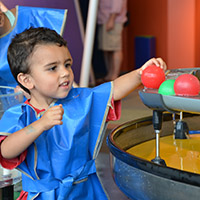Many civilizations, including the Maya, have specific social events that are celebrated as significant moments in an individual’s life. These events are called rites of passage, and they demonstrate transformation within a community and indicate a change to a different social status. We will take a look at some examples of Maya rites of passage and use beloved Disney films to help illustrate their significance. Before we dive in, think about the rites of passage you celebrate with your friends and family and their significance in our culture.
Three Stages
In every rite of passage there are three stages to pass through based on cultural standards: separation, transition, and reincorporation. Before we jump into Maya rites of passage, let’s get a better understanding of each stage:
- Separation: This part removes the initiate from their original role in the community and can happen symbolically, emotionally, or physically. For example, during a coming of age ritual, an individual might be separated from all things associated with their childhood, such as toys, clothing, and food. If we consider weddings as an example, the couple’s engagement might mark the beginning of the separation phase, as their transition to a new life begins.
- Transition: Depending on the culture, the transition period might last a day or even a few weeks. During this timeframe, individuals might feel a sense of renewal or rebirth as they make the transition to their new role within the community. During a wedding, when the couple say their vows and exchange their rings. They are making the transition from engaged to being wed within the eyes of their social community.
- Reincorporation: This final stage of a rite of passage is reincorporation. In this stage, the initiates have crossed the threshold and proven they are ready to take on the responsibilities that comes with their new role. Often, a large celebration takes place to praise the completion of the rite of passage. If we continue to use the wedding example, the reception and all of its traditions might mark the reincorporation phase.
Now that we’ve broken down the three stages of every rite of passage, let’s take a look at what makes Maya rites of passage unique.
The Maya celebrated several important moments throughout their lives, like, birth, the beginning of puberty, and even death. As I discussed in my previous blogs about the Maya Calendar https://ctsciencecenter.org/blog/experiencing-maya-hidden-worlds-revealed-the-maya-calendar/ and Baby Names https://ctsciencecenter.org/blog/experiencing-maya-hidden-worlds-revealed-baby-names-of-the-maya/, the calendar helped determine newborn names. This is just one example of a Maya rite of passage!
Maya Rite of Passage – Coming of Age
In Many cultures, when children reach adolescence, they go through a ritual to show that they can be viewed as adults in their community. Some examples outside of the Maya culture you may be familiar with are Quinceañeras, B’nai mitzvah and B’not mitzvah, and Sweet 16 parties. All of these are when families might host ceremonies or throw large parties to acknowledge their child coming of age.
In Maya culture, once boys returned from their first successful hunt, they performed a bloodletting ritual to confirm that they could be viewed as men within their culture. After completing the ritual, they received a white bead in their hair, and they lived in a separate place known as the “home of unmarried men” until marriage.
When girls were old enough to have children of their own, they tied a shell around her waist to indicate they were of age. She then continued to live with her family until marriage.
For the Maya, once a couple married, they became adults.
Maya Rite of Passage- Marriage
For young Maya, matchmakers determined their life partner. You may have heard this term in the Disney movie, Mulan, where our heroine was expected to prove she had the skills to care for her future husband to the matchmaker, so she could bring honor to her family when matched with her future partner.
In Maya matchmaking, two families joined as allies to negotiate the union of their children, and when the young man’s parents notified the community elders that they’d chosen the boy’s future mate, a ritual ceremony held by the matchmaker signified the negotiated union’s approval. With the matchmaker’s approval of the Union, on a predetermined date set by the matchmaker, the bride was carried on a family matron’s back to her new home.
Maya Rite of Passage- Death
The elders of the Maya civilization were held in the highest regard in many ceremonies and rituals, and death was no exception. The families of the elders prayed to the deceased every year during Yule or winter solstice. The Maya rite of passage for death involves cremation to signify the separation stage. Once the remains were collected, they were poured into water, signifying the transition stage, as the elder’s remains traveled to the underworld or “xibalba.” Once the remains were believed to have reached xibalba, the elder became reincorporated into the realm of ancestors.
The Maya worshipped their ancestors by honoring them in prayer. This is similar to the relationship that Moana had with her grandmother after she passed away, or when Pocahontas addressed her grandmother as “grandmother willow” when her spirit appeared in a willow tree.
Now that we’ve discussed several rites of passage the Maya celebrate, can you make connection to any of our own rites of passage? Would you consider going through these rites of passage? It is interesting to learn what moments in a person’s life should be considered important and worth celebrating even in different cultures such as the Maya. This helps us realize the similarities and differences from the rites of passage we celebrate in America.
Immerse yourself in the world of the ancient Maya and explore one of the world’s most complex and advanced civilizations. Reserve your timed ticket in advance of your visit on CTScienceCenter.org.

Sarena Salmeri is an intern for the Maya: Hidden Worlds Revealed exhibit. In her role she helps to educate visitors about various aspects of the Maya Culture, as well as research different Maya ways of life as they live today and have in the past. She is working towards her bachelor’s degree in Cultural Anthropology at Southern Connecticut State University, aspiring to work as an ethnographer and in museum curation. In her free time, she enjoys taking her dog for long walks across town, collecting artwork from the places she has traveled, and reading different ethnography books about a variety of cultures.


